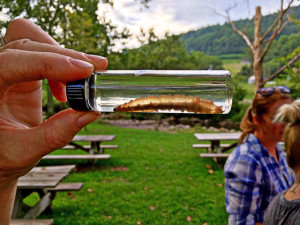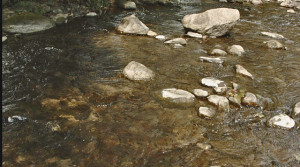The expression and the actual practice is “the canary in the coal mine,” a means to detect deadly levels of carbon dioxide gas that overwhelms the canary, signaling to the miners that they might succumb next, and so they are fairly warned to escape.
There are comparable early warning signs, using other small creatures, to detect whether the river and stream waters that we drink, fish and swim in may be “impaired,” or significantly degraded.
Unfortunately, we do have “impaired waters” – so this is not an academic question.
All our County’s streams are affected by human activities, especially development, and some do not meet the standards of the Clean Water Act and Virginia Water Quality Standards for recreational use and aquatic life.
We have to be concerned about Catoctin Creek and Goose Creek and their tributaries, Little River, Limestone Branch, Piney Run, Broad Run and Sugarland Run. We all have an obligation as stewards to use but not alter or compromise this most essential natural resource, the waters by which we live.
We have pollution from storm water runoff, grazing, failing septic tank systems. The more impervious surfaces we have, the more our watersheds are compromised. Nor can we ignore the fecal bacteria mostly due to livestock. We have to remediate against these polluting practices.
The good news is that there are things we can do to protect and preserve our waterways and we have the means to detect when our streams are “impaired.”
The Goose Creek Association, for example, has an aggressive tree planting program, “the Goose Creek Challenge,” working to increase our riparian buffers that helps keep our waterways clean, because the trees and ground cover filter the rain and run-off, thus reducing erosion; the PEC and Loudoun County government have pitched in as well with similar programs.
As for detecting the health of our waterways, fly fishermen well know the tiny creatures, the “canaries in the stream,” that help us figure this out; fishermen put these creatures on their hooks as bait before they cast their lines.
These small creatures include crayfish, mayflies, stoneflies, caddisflies, midges, fish flies, dragon flies, beetles, springtails, water mites, scuds, sowbugs, snails, clams, mussels, leeches, worms, flatworms, hellgrammites, and horse fly larva, to name some of those that matter.
These creatures are benthic – dwell on the lower part of the stream – and they are macro invertebrates, that is, big enough to see (macro) but spineless (invertebrates).
The principle is simple, by knowing who among these bug size creatures flourish in a clean stream, we know how healthy the stream waters may be.
But some of these creatures are pollution tolerant, dirty streamers, and an overabundance of these pollution tolerant aquatic insects in any stream suggests the stream is in poor health.
In 2009, Loudoun County had its streams assessed and 78% were found impaired for aquatic life due to poor benthic conditions. Plainly, a discouraging report that requires our attention to this day.
Statewide, almost half of our rivers and streams (10,488 miles) are impaired and unsuitable for recreation per the DEQ 2014 Report.
We must improve the quality of our streams by following an array of best and proven practices (conservation landscaping, impervious surface removal, rain gardens, dry wells, rainwater harvesting) and we must actively continue to monitor our streams at the stream sites already established around our County from Lovettsville south to Middleburg and East to Sterling and the County line.
We must study these bottom dwelling creatures and learn what they can tell us about the health of our streams.
Statewide these surveys are done by volunteers, often with the assistance of the Department of Environmental Quality (DEQ).
In Loudoun County, there are organization you may volunteer to help to monitor these creatures and our streams – the Goose Creek Association, Loudoun Watershed Watch, Loudoun Wildlife Conservancy, VASOS, and Izaak Walton League’s “Creek Freaks.” If you have additional questions on citizen monitoring, you can get in touch with DEQ’s James Beckley (at (804) 698-4025) or by e-mail.
If you want more information on how benthic monitoring works, you may find this short movie I made of some use.


